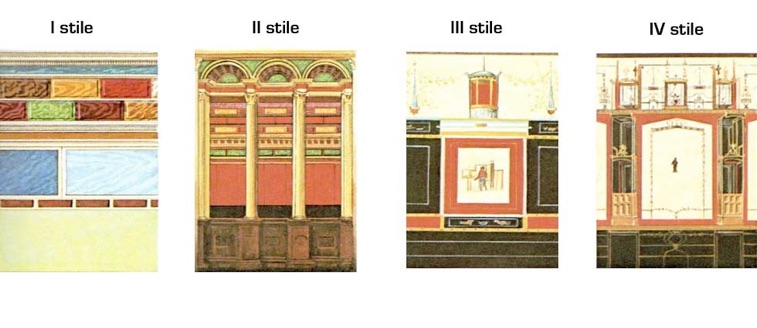Archaeological tours, packages and exclusive multy day excursions in Campania for tourists, lovers,
scholars and students.





Archaeological tours, packages and exclusive multy day excursions in Campania for tourists, lovers,
scholars and students.
The first scholar to classify the Pompeian painting was the German archaeologist August Mau that stood out in four styles.
The first style, referring to the period from III to I century BC, of Greek origin, structural style or fouling, was an imitation stucco, often in relief, the technique called opus quadratum, used to coat the marbles exterior walls of public buildings and religious in the Doric style. Significant examples of this style are in the House of the Faun in Pompeii and in the Samnite House in Herculaneum.
The second style, described in detail by Vitruvius, architectural style, was introduced in the I century. BC, and reworking some elements of the earlier style. Inspired by the scenery of the Hellenistic-Roman theater, distributed in a bottom-shaped podium, on which rested in the middle of the faux wall structures, columns, niches, with characters represented megalografie-size or scale to a slightly more small, floral elements and animals, and seen in perspective with illusionistic realism final effect of a trompe l'oeil. Examples of the second style is found in the triclinium of the Villa Oplonti, in the Villa of the Mysteries, and frescoes from the Villa of Boscoreale, now housed at the Metropolitan Museum in New York and the Archaeological Museum of Naples.
Over the last years of the century. B.C. under the principate of Augustus with the third style, called Pompeian style, or ornamentation, takes over the decorative. The optical illusion disappears, replaced by solid funding, usually in black, red or white, with a central miniature paintings depicting scenes of various kinds, mostly mythological, enclosed in kiosks or squares pinakes said. The walls were designed as split levels a lower base, divided by the median, through a dais decorated various ornaments. Typical were the candlesticks, the plant shoots and thyrsus. In Pompeii still remain fifty examples as most of the material that belongs to the third style has been lost. Some of the finest examples of the third sitile can be seen in the House of the Vetti and in the House of Lucretius Fronto.
From the age Claudia develops the fourth style, defined fantastic style, which in its first phase sees the return of the architectural elements of the second style, recreated amazing sleight of type. Scenes of heroic character-mythological and allegorical figures, painted with warmer colors representing the elements and accessories in yellow gold. In the Flavian period, so in the last years of the city of Pompeii, appear real scenes and great landscapes. It 's the most popular decoration in the Vesuvius area, since many houses were redecorated after the violent earthquake of 62 AD. C. The House of the Tragic Poet, one of the Vetti and Menander in Pompeii, Shrine of the Augustans and the House of the Stags at Herculaneum have some of the finest examples of decorations in the fourth style.

PAINTING STYLES OF POMPEII
Pompeii Tour guide - Herculaneum Tour guide - Stabiae Tour guide - Oplontis Tour guide - Naples Tour guide
Amalfi Coast - Sorrento - Positano - Paestum Tour guide - Capua Amphitheater - Procida - Ischia - Capri
Copyright © Pompeiin.com - E-mail: info@pompeiin.com

